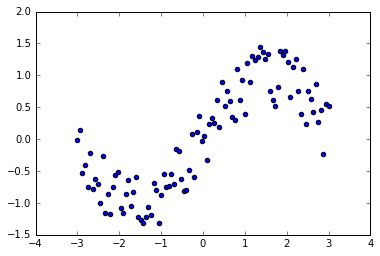"""Simple tutorial for using TensorFlow to compute a linear regression.
Parag K. Mital, Jan. 2016"""
'Simple tutorial for using TensorFlow to compute a linear regression.\n\nParag K. Mital, Jan. 2016'
%matplotlib inline
import numpy as np
import tensorflow as tf
import matplotlib.pyplot as plt
plt.ion()
n_observations = 100
fig, ax = plt.subplots(1, 1)
xs = np.linspace(-3, 3, n_observations)
ys = np.sin(xs) + np.random.uniform(-0.5, 0.5, n_observations)
ax.scatter(xs, ys)
fig.show()
plt.draw()
/home/heythisischo/anaconda2/lib/python2.7/site-packages/matplotlib/figure.py:397: UserWarning: matplotlib is currently using a non-GUI backend, so cannot show the figure
"matplotlib is currently using a non-GUI backend, "

X = tf.placeholder(tf.float32)
Y = tf.placeholder(tf.float32)
W = tf.Variable(tf.random_normal([1]), name='weight')
b = tf.Variable(tf.random_normal([1]), name='bias')
Y_pred = tf.add(tf.mul(X, W), b)
cost = tf.reduce_sum(tf.pow(Y_pred - Y, 2)) / (n_observations - 1)
learning_rate = 0.01
optimizer = tf.train.GradientDescentOptimizer(learning_rate).minimize(cost)
n_epochs = 1000
with tf.Session() as sess:
sess.run(tf.initialize_all_variables())
prev_training_cost = 0.0
for epoch_i in range(n_epochs):
for (x, y) in zip(xs, ys):
sess.run(optimizer, feed_dict={X: x, Y: y})
training_cost = sess.run(
cost, feed_dict={X: xs, Y: ys})
print(training_cost)
if epoch_i % 20 == 0:
ax.plot(xs, Y_pred.eval(
feed_dict={X: xs}, session=sess),
'k', alpha=epoch_i / n_epochs)
fig.show()
plt.draw()
if np.abs(prev_training_cost - training_cost) < 0.000001:
break
prev_training_cost = training_cost
fig.show()
1.43989
1.30686
1.18916
1.08503
0.992879
0.911325
0.839141
0.77524
0.718663
0.668564
0.624192
0.584885
0.550058
0.519194
0.491835
0.467578
0.446063
0.426977
0.410039
0.395001
0.381647
0.369783
0.359238
0.349861
0.341519
0.334094
0.327481
0.321587
0.316332
0.311643
0.307455
0.303713
0.300366
0.29737
0.294686
0.292278
0.290117
0.288175
0.286427
0.284853
0.283433
0.282151
0.280991
0.279942
0.27899
0.278125
0.277339
0.276623
0.27597
0.275373
0.274826
0.274325
0.273865
0.273442
0.273052
0.272693
0.27236
0.272052
0.271767
0.271501
0.271254
0.271024
0.27081
0.270609
0.270421
0.270245
0.27008
0.269925
0.269779
0.269642
0.269512
0.26939
0.269274
0.269165
0.269062
0.268964
0.268871
0.268783
0.268699
0.26862
0.268544
0.268472
0.268404
0.268339
0.268277
0.268218
0.268161
0.268107
0.268056
0.268007
0.26796
0.267916
0.267873
0.267832
0.267794
0.267756
0.267721
0.267687
0.267654
0.267623
0.267594
0.267565
0.267538
0.267512
0.267487
0.267464
0.267441
0.267419
0.267398
0.267378
0.267359
0.267341
0.267324
0.267307
0.267291
0.267276
0.267261
0.267247
0.267234
0.267221
0.267209
0.267197
0.267186
0.267176
0.267165
0.267156
0.267146
0.267137
0.267129
0.267121
0.267113
0.267105
0.267098
0.267092
0.267085
0.267079
0.267073
0.267067
0.267062
0.267057
0.267052
0.267047
0.267043
0.267039
0.267034
0.267031
0.267027
0.267023
0.26702
0.267017
0.267014
0.267011
0.267008
0.267006
0.267003
0.267001
0.266998
0.266996
0.266994
0.266992
0.26699
0.266989
0.266987
0.266985
0.266984
0.266982
0.266981
0.26698
0.266979
0.266978
0.266976
0.266975
0.266974
<matplotlib.figure.Figure at 0x7f8c0037e890>
